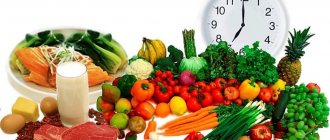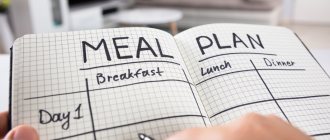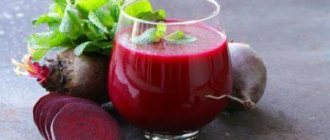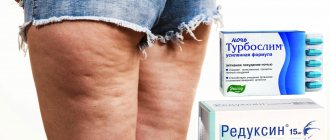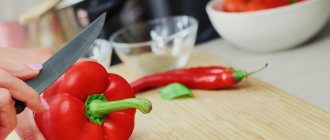A cholesterol-lowering or hypocholesterolemic diet is usually prescribed for medical purposes in order to significantly lower blood cholesterol levels. And as an addition, you can lose a few extra pounds. This diet was developed with the help of cardiologists, since increased cholesterol can lead to various cardiovascular diseases and atherosclerosis. The risk of developing a heart attack and coronary heart disease increases significantly. The fact is that hypercholesterolemia can also be a hereditary disease, and as a rule, a diet has been specially developed for such people that will help reduce the level of bad cholesterol in the blood.
What are the differences between “good” and “bad” cholesterol?
Before you look at the menu, you need to understand what cholesterol is. This is a lipid substance that moves in the body, combining with proteins and other molecules into complexes - lipoproteins. They come in high and low density. High-density lipoproteins (HDL) are considered “good” and low-density lipoproteins (LDL) are considered “bad”.
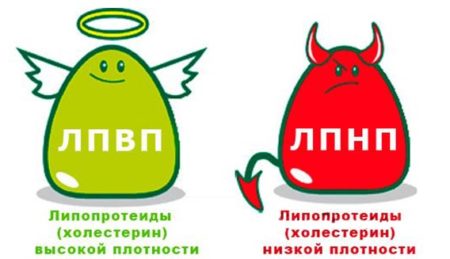
LDL and HDL
The density of the connection plays an important role, since LDL transports the cholesterol needed by cells from the liver through the vessels, but at the same time, excess cholesterol settles on their walls. HDL, on the contrary, helps neutralize and eliminate bad cholesterol. “Good” cholesterol is able to redirect low-density lipids to the liver, where they are processed and excreted from the body.
Legumes

Important cholesterol-free foods are peas, chickpeas, beans and lentils. Legumes contain more protein than meat, as well as minerals and fiber. Plant foods strengthen blood vessels and, thanks to the presence of antioxidants, prevent aging. Legumes are good for the nervous system - B vitamins improve the conductivity of neural signals.
Nutritionist advice:
- To reduce bad cholesterol after 50, eat up to 100 grams of legumes every day.
- Replace refined grains or processed meats with beans.
- Use legumes in any diet. They promote weight loss and prevent protein deficiency.
How to eat to lower cholesterol?
Changing a person’s usual diet always becomes stressful, so you shouldn’t go on a strict diet, the main thing is to understand which cholesterol-free foods should be consumed to a greater extent. You need to have a positive attitude towards adjusting your menu, because even such small changes can reduce the level of bad cholesterol.
Attention! Scientists have proven that if a person smokes 20 cigarettes a week and drinks coffee at least 2 times a day, his cholesterol level will increase several times.
As for the rules of a home diet, here it is worth considering several recommendations from doctors that are aimed at reducing cholesterol:
- Avoid alcoholic beverages in large quantities. It is especially important to say “no” to alcohol for people with hypertension, cardiovascular diseases, and diabetes. It is unacceptable to drink beer (more than 0.3 liters per day), vodka or cognac (more than 30 ml). If a person has no health problems, then doctors allow drinking no more than 150 ml of dry red wine. Only this drink dilates blood vessels, removes harmful cholesterol, and normalizes blood pressure.
- Drink at least 2 liters of water per day. If the body does not receive the required amount of water, the blood becomes thicker, which increases the risk of blood clots. The indicated volume of water does not include juices, fruit drinks, compotes, tea, coffee. Please note that juices should not be packaged, as such products contain a lot of sugar and preservatives. It is better to drink freshly squeezed juices.
- It is worth giving up eating baked goods, white bread, and pastries. These are quickly digestible carbohydrates that immediately enter the bloodstream. If the energy received from this food is not used up in time, this leads to the formation of excess fat.
- The diet should consist of 45% vegetables and fruits. They contain vitamins, minerals and fiber, which promote active metabolism and improve digestion.

Fresh vegetables and fruits
- Red and orange vegetables and fruits will help combat high cholesterol. It is better to subject this group of products to minimal heat treatment so that they do not lose their beneficial properties.
- Special attention should be paid to berries, because they can simply be frozen for the winter. Strawberries, strawberries, red currants, sea buckthorn, and red grapes are great for lowering cholesterol.
- It is better not to use red meats on the menu. They can be replaced with dietary meat of rabbit, chicken, and turkey.

Diet meat
- Cereal porridge will help to recharge your body very well in the morning. You can boil them, pour hot milk, add honey, dried fruits, nuts, seeds.
- Consumption of confectionery products produced with trans fats has an adverse effect on vascular health.
Important! It is not difficult to recognize such components in your favorite treats. First of all, you should read the composition. Such products may state that they contain palm oil. Chocolate products based on such oils do not melt in your hands, since their melting point is higher than 37 degrees.
- It is better to cook dishes without frying. It is preferable to bake products in the oven, cook in foil on the grill, steam, in a slow cooker, or stew. It is better to replace sunflower and butter with olive or flaxseed oil. Mayonnaise should be completely removed from the menu.
These are basic recommendations that are important to follow to prevent the development of atherosclerosis. At the same time, it is important to overcome your bad habits. Tobacco smoking and alcoholism are the main causes of vascular damage.
Tea, coffee, cocoa
Tea is a drink that is completely devoid of any fat, which means it cannot contain cholesterol in principle. The famous tea tree oil is collected bit by bit from the leaves through distillation. The astringent taste of tea is due to the large amount of tannin present in this product. Tannin is a substance that binds everything around it. This applies to both fatty food components (including low-density lipoproteins) and beneficial microelements. It has been proven that when drinking tea, a person will not get iron from it, even if he eats a large amount of meat.

Few people perceive coffee as a product for weight loss. Coffee is the most popular and affordable energy drink with which millions of people around the world start their mornings. Until recently, coffee was included in the stop list of foods for people suffering from high cholesterol. The whole point is its ability to increase blood pressure, which is usually elevated in this group of people or is at the upper limit of normal.
Today, scientists have rehabilitated coffee and even allowed it to hypertensive patients. In fact, independent studies have shown that regular, moderate coffee consumption even lowers plasma lipid levels. Both instant and natural ground coffee have no cholesterol. It contains a small amount of essential oil, which can be easily verified by looking at the surface of freshly brewed coffee. A large number of organic acids (malic, caffeic, chlorogenic, acetic, citric) stimulate the functioning of all organs.
Cocoa is a product unique in its composition. On average, cocoa powder contains about 10 g of fat, but this fat is extremely healthy. Plant polyunsaturated fatty acids in combination with polyphenols act like a medicine. Properly prepared cocoa helps neutralize the fat that a person consumed before drinking a cup of this drink. It is important not to add large amounts of sugar and milk to it, so as not to reduce its beneficial properties. Finally, doctors warn about the nutritional value of cocoa.
So, 200 g of a drink with milk and sugar is equivalent to 200 Kcal. We can say that this is not just a drink, but food, a healthy snack, and you shouldn’t add high-calorie sweets to it.
What foods are low in cholesterol?
People who want to find a cholesterol-free product will have a hard time since almost every animal product contains this substance. The main difference is the amount or ratio of “good” and “bad” cholesterol. Doctors have identified several groups of foods that are low in LDL. To make it easier to navigate, we will present in the list products with the maximum and minimum amounts of this substance.
- Meat. From this group, beef and chicken liver, brains, pork, lard, kidneys, sausages, and smoked meats are prohibited. It is acceptable to eat chicken, horse meat, lean lamb, turkey, skinless duck, rabbit, veal, and boiled sausage.
- Fish and seafood. Doctors recommend eating more fish than meat, because this product contains a lot of unsaturated fatty acids Omega-3 and Omega-6. It is better to avoid mackerel, herring, carp, shrimp, crayfish, stellate sturgeon, sardines in oil, and caviar. Low cholesterol content was observed in crabs, pike, horse mackerel, cod, and tuna. You can eat all types of fish that are classified as medium or low fat - up to 12% fat.
- Milk and dairy products. The calcium contained in these products is important for the health and elasticity of blood vessels. It is better to consume low-fat dairy products: kefir, fermented baked milk, cottage cheese, yogurt, cow's milk. Full-fat sour cream, cream, condensed milk, butter, margarine and cottage cheese should be prohibited.
Both cholesterol and fat content of a product depend on each other. For example, 0% cottage cheese contains only 1 mg of cholesterol per 100 g of product, and 20% cottage cheese contains 17 mg. Fat content is considered high if its percentage is above 15%.

Low fat fermented milk products
- Eggs. If you eat chicken eggs, it is better to separate the yolk, as it contains a large amount of cholesterol. You can only eat protein. In addition, it is better to boil quail and chicken eggs rather than fry them.
- Cheeses. This type of dairy products is specially identified as a separate group, since they are often not recommended for consumption due to their high fat content. Not everyone knows that certain types of cheese can still be included in your menu: homemade cheese (no more than 4% fat), sheep cheese, processed cheese (no more than 20% fat), “Limburg” 20%.
- Vegetables, fruits, berries, herbs. Plant foods can be consumed without special prohibitions and restrictions.
- Cereals. It is best to give preference to oatmeal, buckwheat, and barley. It is worth moderating the consumption of round polished rice, semolina, and wheat cereals.
- Bakery products. Due to the high glycemic index of these products, it is allowed to eat whole grain bread, crackers, and crispbreads. It is worth reducing the amount of white bread and baked goods.
As a result, it is simply impossible to create a list of animal products that do not contain cholesterol, because this substance is everywhere. The main thing is to identify useful and harmful options for yourself. Often, for an accurate calculation, a table is used that shows how much cholesterol is contained in 100 g of the selected product.
Menu for a week with a hypocholesterolemic diet
The menu for a week with high cholesterol levels should consist only of permitted foods, of which there are quite a lot, so creating a daily balanced diet will not require much effort.
Below is a sample menu based on which you can come up with your own meal plan.
Monday:
- breakfast - low-fat cottage cheese (150 grams), green or herbal tea, oatmeal;
- second breakfast - some berries or an apple;
- lunch - low-fat meat or vegetable soup, boiled chicken breast (100 grams), vegetable salad seasoned with a small amount of vegetable oil, a slice of rye black bread;
- afternoon snack - unsweetened yogurt or any fruit;
- dinner - two boiled egg whites, green beans with carrots (stewed or cooked in a double boiler).
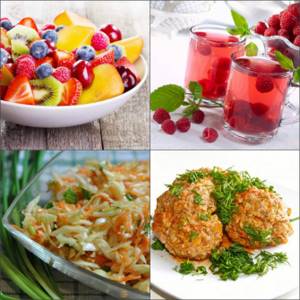
Tuesday:
- breakfast - fruit salad, a glass of low-fat fermented milk product, a slice of whole grain bread;
- second breakfast - any fruit or fruit jelly without sugar;
- lunch - baked or steamed fish (150 grams), cabbage salad with carrots, seasoned with balsamic or soy sauce and a small amount of vegetable oil;
- afternoon snack - cheese with rye or whole grain bread and herbs;
- dinner - two stewed beef meatballs with stewed vegetables (peppers, cauliflower, carrots).
Wednesday:
- breakfast - buckwheat porridge and tomato or vegetable juice;
- second breakfast - baked apple with honey, black tea;
- lunch - pureed vegetable soup, a slice of bread with bran, salad with mushrooms (oyster mushrooms or champignons).
- afternoon snack - green tea and one marshmallow;
- dinner - stewed rabbit (250 grams) and Greek salad.
Thursday:
- breakfast - cheesecakes with fruit jam (4 pieces), apple and carrot salad with nuts, a glass of low-fat fermented milk product;
- second breakfast - rosehip decoction, dried fruits (5 prunes and the same amount of dried apricots);
- lunch - gazpacho, boiled veal (150 grams), a piece of gray or whole grain bread;
- afternoon snack - low-fat cottage cheese with raisins and unsweetened compote;
- dinner - durum wheat pasta and baked or steamed fish (150 grams).
Friday:
- breakfast - millet porridge with apple, rosehip decoction;
- second breakfast - any low-fat fermented milk product;
- lunch - seafood and olive salad, a glass of any unsweetened fruit juice;
- afternoon snack - some grapes;
- dinner - boiled beans with spices, tomato and cucumber salad, seasoned with a small amount of vegetable oil.
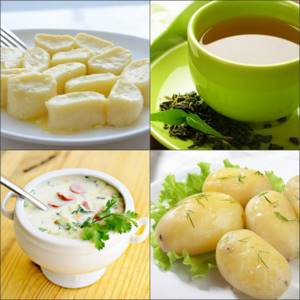
Saturday:
- breakfast - lazy dumplings, black or green tea;
- second breakfast - tomato with cheese;
- lunch - vegetable hash, a slice of bran or whole grain bread;
- afternoon snack - any two fruits;
- dinner - boiled potatoes, turkey, vegetable salad.
Sunday:
- breakfast - weak coffee with milk, oatmeal and one egg white;
- second breakfast - fruit jelly or fruit ice cream;
- lunch - low-fat chicken soup, boiled or baked veal (100 grams), radish salad;
- afternoon snack - orange or unsweetened yogurt;
- dinner - risotto with mushrooms or spaghetti in tomato sauce, boiled beet salad.
Universal “cleaners” of blood vessels from cholesterol
There are simple, but amazing in their composition, products that effectively fight cholesterol plaques in the blood. Their benefits are confirmed by analyzes of people who focused their diet on these products.
Carrot
A big shift in the study of the effects of food on cholesterol levels was seen after research on carrots.

Fresh carrots
It turns out that two raw carrots can lower LDL. If you consume 2 carrots every day for two months, your bad cholesterol level will decrease by 15%. Of course, at the same time you need to monitor your diet and give up cigarettes and alcohol.
Additionally, this root vegetable helps strengthen gums and enamel.
Tomatoes
Red tomatoes can lower LDL. This plant is often called an antidote to dangerous cholesterol. It's all due to lycopene. This substance gives tomatoes their red tint. Scientists have calculated that 25 mg of lycopene in 24 hours can reduce cholesterol by 0.1 mg.
Advice! In the winter, when it is difficult to purchase fresh tomatoes, they can be replaced with tomato juice. It is enough to drink 2 glasses of this drink per day.
Tomatoes have a lot of potassium. This element perfectly strengthens the myocardium. Due to its watery structure, it is impossible to gain weight from eating this vegetable. It contains only 22 kcal per 100 g. Tomato increases the elasticity of blood vessels, strengthens their walls, and promotes the removal of LDL.
Nuts
The table of cholesterol-lowering foods is not complete without nuts and seeds. These foods are rich in unsaturated fatty acids, which cleanse blood vessels. If you eat 60 g of nuts per day, your cholesterol level will decrease by at least 5%. And with systematic consumption of nuts, cholesterol levels can decrease by 7% within 2-3 months.
Important! Scientists have discovered a pattern - the higher the concentration of LDL, the faster the oils contained in nuts reduce it.
Nuts contain vitamins B, A and E. Their kernels are recommended for the prevention of senile dementia and early myocardial infarction.
Black radish
You can make salads or juice from this root vegetable. But it is worth remembering that this product should be consumed with caution by people with gastrointestinal diseases. It is better to finely grate the radish and season with olive oil before eating.

Black radish juice
It effectively cleans blood vessels, resolves cholesterol plaques, and strengthens the immune system. After consuming radish, the blood plasma is cleared of toxins and heavy metals.
Garlic
Garlic joins the list of cholesterol-lowering foods. The table of “cleansers” is not complete without this vigorous vegetable. Its taste and smell are specific due to the presence of allinine. This substance is transformed into allicin during cutting or chewing. It is this substance that cleanses blood vessels from cholesterol.

Garlic
Those people who eat 1-2 cloves of garlic a day will have complete order with their blood vessels. People with stomach and intestinal diseases should not be treated with garlic. An additional bonus is the normalization of blood pressure, which is important for people who suffer from cardiovascular diseases. But sometimes garlic is not combined with taking antihypertensive drugs.
Now we know which foods contain cholesterol and how much. The product table helps to accurately determine the amount of this substance. Men after 40 years of age, and women after 50 years of age, are at risk for atherosclerosis, since metabolism decreases significantly. The list of healthy and harmful foods should be used in the lives of both sick and healthy people.
Fruits and berries, vegetable oils, vegetables
It is wrong to say about all fruits that they do not contain fat. Perhaps the most popular fruit with a high fat content for a vegetable product is avocado. There are about 15 g of fat per 100 g of product, but they are all polyunsaturated, which means they will not lead to the deposition of plaques on the walls of blood vessels.

Equally interesting information about olives. These berries are a rich source of oils, but all of them will not harm the cardiovascular system, and will even strengthen it. Polyunsaturated acids such as linoleic, oleic and linolenic acids will remove bad cholesterol from the blood vessels.
Vegetable oils. This product is a real boon for manufacturers and marketers all over the world. On almost every bottle label with any vegetable oil you can find the inscription “cholesterol free”, and this is the absolute truth. However, stating such obvious things is equivalent to calling a lemon sour. Any vegetable oil does not and cannot contain cholesterol. Moreover, all components of this product actively combat its deposition on the walls of blood vessels.
Things are somewhat different with vegetable oil that has been fried. With such heat treatment, polymers of fatty acids are formed in the oil, which can cause an increase in cholesterol in the body, and all this - not to mention a large number of carcinogenic and toxic substances (acrolein, acrylamide, heterocyclic amines and peroxides) that can cause cancer.
Vegetables. They have no cholesterol at all, and therefore you can include them in your diet without the slightest fear of increasing the level of lipid components in the blood plasma. Moreover, this category of products, like no other, is rich in fiber, which helps remove fatty components from blood vessels and also normalizes digestion processes.
Foods fortified with essential fatty acids
You can find Omega-3 in:
- salmon;
- tuna;
- trout;
- walnuts;
- flax seeds and oil;
- pumpkin seeds;
- hemp oil;
- soybean oil.
To saturate your body with Omega-6, be sure to consume the following oils:
- corn;
- soy;
- sunflower;
- safflower
Seeds and oils will be a good dressing for salads and fish dishes. The main thing is not to abuse them.
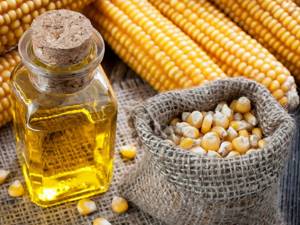
Corn seed oil
Why know your blood lipid levels?
Cholesterol is an organic compound produced by the body and found in food. On average, the normal amount in the blood is from 3.6 to 5.2 mmol/l, while “harmful” LDL in men is 2.25-4.82, in women up to 3.5. “Good” HDL is 0.7-1.7 for the stronger sex, 0.9-1.9 for the weaker sex. When there is an excess of bad cholesterol, plaques form in the vessels and gradually clog the lumen. This disease is called atherosclerosis, and formations of cholesterol are called atherosclerotic plaques. When veins and arteries are blocked, blood flows poorly to organs and tissues, and the brain and heart are poorly supplied. The functioning of the whole organism is disrupted, hypoxia occurs.
Knowing your cholesterol level helps prevent diseases, and if they have already begun, begin treatment in the early stages, changing your lifestyle and diet. This way you can avoid serious consequences and complications, as well as prolong your life.
Harmful factors influence elevated cholesterol levels. List of main ones:
- Passion for bad habits.
- The presence of obesity in a person.
- Maintaining a sedentary lifestyle.
- Diseases of the endocrine system, hormonal levels.
- Poor nutrition.
Sources of phytosterols
You can compensate for the deficiency of phytosterols in the body with the following foods:
- sea buckthorn, olive, sesame and sunflower oils;
- soy, sesame and all types of nuts;
- beans, peas and corn;
- figs, lemon and orange;
- tomatoes:
- wheat sprouts.
Before consuming these foods, ask your doctor to determine the appropriate amount of each for you.

wheat germ
Consequences of human obesity
In addition to the fact that a person experiences extreme discomfort due to excess weight, multiple pathologies develop in his body:
- The functioning of the heart is impaired, as it is forced to pump much more blood than with moderate weight.
- The condition of blood vessels changes for the worse. They become clogged with atherosclerotic plaques.
- The nervous system ceases to function normally.
- The functioning of the gastrointestinal tract is disrupted.
- The respiratory system suffers from the fact that the tissues of the respiratory organs become overgrown with fat.

All these factors lead to the development of many diseases:
- Hypertension;
- Angina pectoris;
- Heart attack;
- Stroke.
It is always better to prevent the development of a disease than to treat it. Therefore, it is necessary to take preventive measures.
Sources of fiber
Many foods are enriched with plant fiber. By adding them to your diet, you can not only improve your body health, but also have a tasty meal. So, fiber is found in:
- pumpkin and sunflower seeds, as well as flax and sesame seeds;
- freshly squeezed juices;
- walnuts and hazelnuts, cashew almonds and pistachios;
- barley, buckwheat, oatmeal, wheat porridge;
- spinach, asparagus, legumes, white cabbage, broccoli, carrots, cucumbers, radishes, potatoes and beets;
- black currants, raspberries, strawberries, peaches, apricots, bananas, pears, apples and grapes.
In order not to harm your body, the above products should be consumed in reasonable quantities.
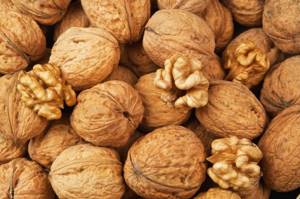
Nuts
Spices
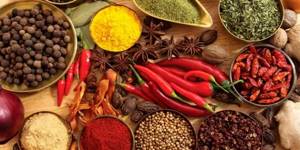
A cholesterol-free diet involves adding turmeric to the diet. The spicy spice cleanses blood vessels from atherosclerotic plaques, reduces the amount of lipids, normalizes weight and blood pressure.
Add turmeric to prepared dishes or consume it in its pure form.
You can mix the spice with milk or tea.
A natural way to lower cholesterol is to reduce the amount of salt in your diet. A person over 50 needs no more than 5 g daily. It is important to reduce sugar intake to 2-3 teaspoons. It is present in junk food - sweet soda, cakes, fast food or ice cream. Cholesterol-free foods include garlic, which contains allicin, which normalizes blood pressure and LDL levels.
Foods fortified with cholesterol
To protect your body from the accumulation of LDL, experts recommend minimizing your intake of:
- semi-finished products and purchased sausages;
- pate based on offal;
- fish caviar;
- egg yolks;
- hard cheese;
- shrimp and seafood;
- canned meat or fish dishes;
- butter and dairy products with a high percentage of fat.
During the period of therapeutic lowering of LDL levels, it is better to avoid these products completely.
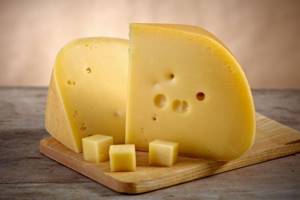
Hard cheeses
What causes extra pounds?
The first thing that does not suit an overweight person is aesthetic dissatisfaction. But the concept of beauty comes last for doctors.
From a medical point of view, non-compliance with aesthetic concepts of beauty is the least important factor in the problems of an overweight person. The appearance of a fat person is just the shell of a time bomb. What happens inside his body is much more serious than aesthetic parameters.
As obesity develops, LDL accumulates in the blood. This, in turn, leads to the development of atherosclerosis. Atherosclerosis is a chronic disease in which fat (LDL) accumulates in the blood vessels. These fats are deposited first in the form of plaque, then this plaque forms into atherosclerotic plaques.
Over time, these plaques lose their shape and strength, turning into blood clots. Blood clots further narrow the lumen of the vessel, disrupting blood flow. Accordingly, body tissues no longer receive adequate oxygen and nutrients. But this is not the worst thing.
Further, with the development of thrombosis, a piece often separates from the thrombus, or it breaks off entirely and enters the bloodstream. In those places where the lumens of the blood vessels are narrowed by three quarters, the blood clot gets stuck. And depending on the location, necrosis (infarction) develops: kidney, liver, intestines, heart.
If this occurs in the vessels of the brain, a stroke develops.
In addition to these most dangerous consequences, there are many more possible pathologies:
- LDL, which appears due to excess weight, accumulates in bile and forms gallstones.
- The deposition of fat in the intestines leads to its displacement.
- For the lungs, this is fraught with overgrowing of their walls with fat.
In addition to the listed negative consequences, general metabolic processes decrease, affecting the body with a sharp decrease in the quality of life.
Why does cholesterol increase?
Before you start a diet, you should find out what triggered the increase in cholesterol in the body. It is a mistake to think that the cause of everything is poor nutrition. Experts have proven that cholesterol levels can rise to critical levels due to:
- obesity;
- hypertension;
- elderly;
- coronary heart disease;
- diabetes mellitus;

Diabetes
- impaired thyroid function;
- hereditary predisposition;
- gallstone disease;
- abuse of alcoholic beverages.
Results of a hypocholesterol diet
Best materials of the month
- Coronaviruses: SARS-CoV-2 (COVID-19)
- Antibiotics for the prevention and treatment of COVID-19: how effective are they?
- The most common "office" diseases
- Does vodka kill coronavirus?
- How to stay alive on our roads?
This diet helps to significantly reduce and normalize cholesterol levels in the blood, and also helps improve the condition of blood vessels and the liver. But in order to completely normalize cholesterol levels, diet alone is not enough. It is recommended to take medications prescribed by a doctor, so before “settling” on such a diet, you should consult a cardiologist and nutritionist. The diet is very well balanced, so it can be used throughout life. Thus, having tried this method once and convinced of its effectiveness, you can make such nutrition a way of life. And as a positive addition to such a diet, there will be weight loss and maintaining it at normal levels for quite a long time. In addition to the low-cholesterol diet, it is very good to introduce sports into your daily routine and get rid of bad habits, such as smoking and alcohol. And then you will feel how much your life has changed for the better.
